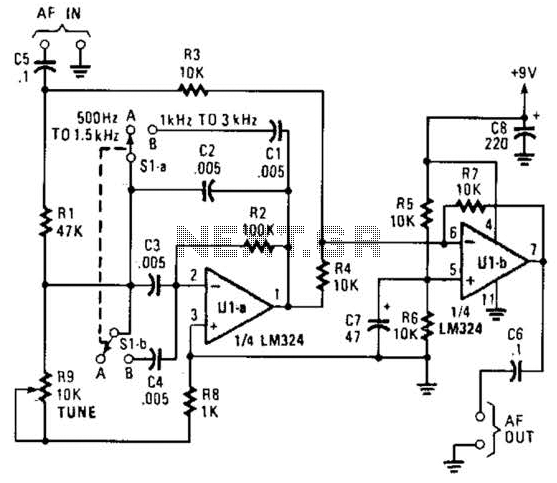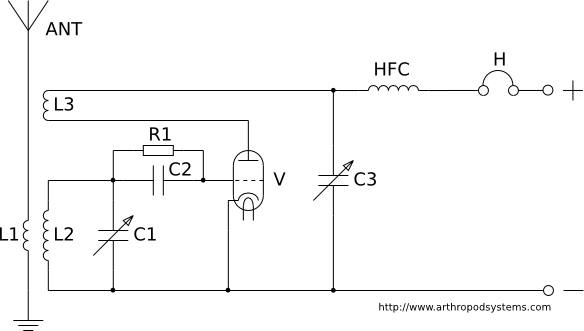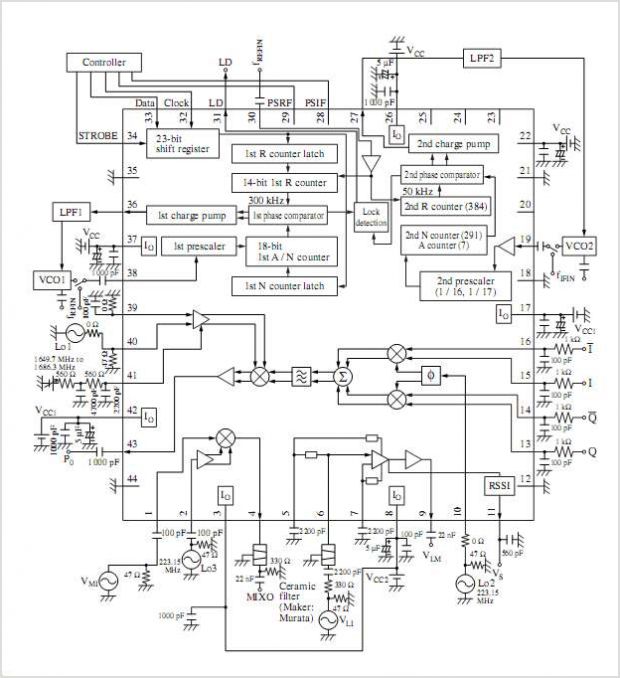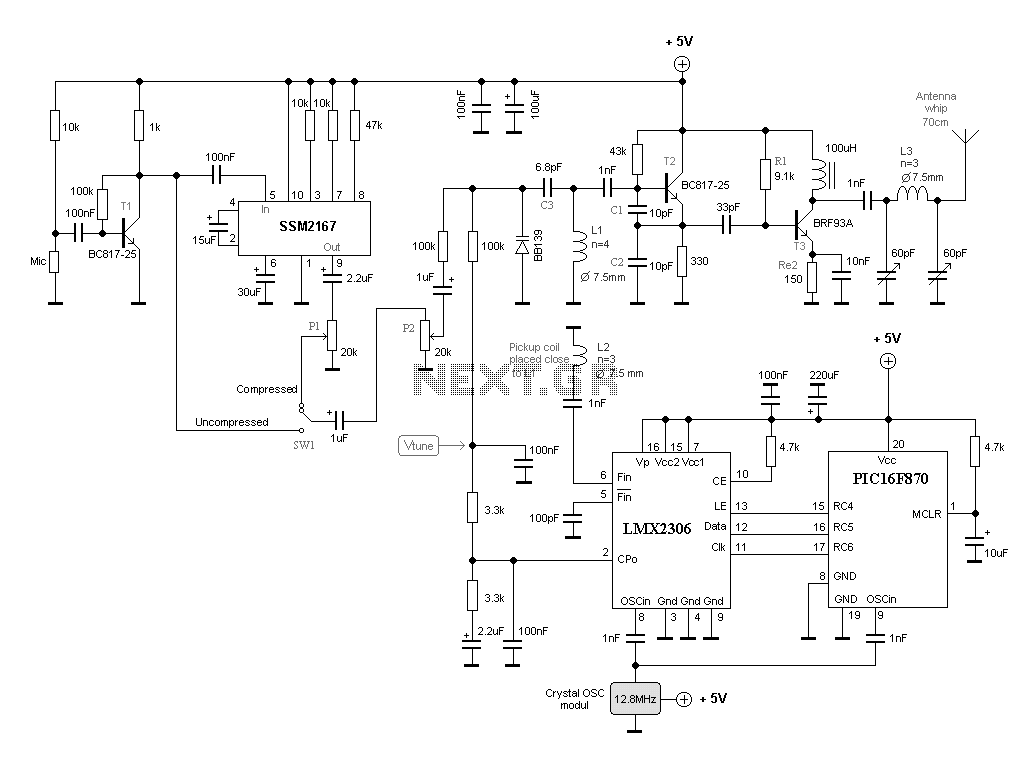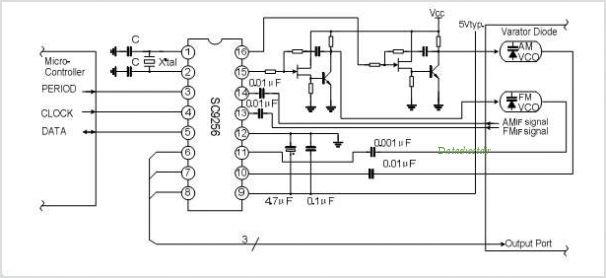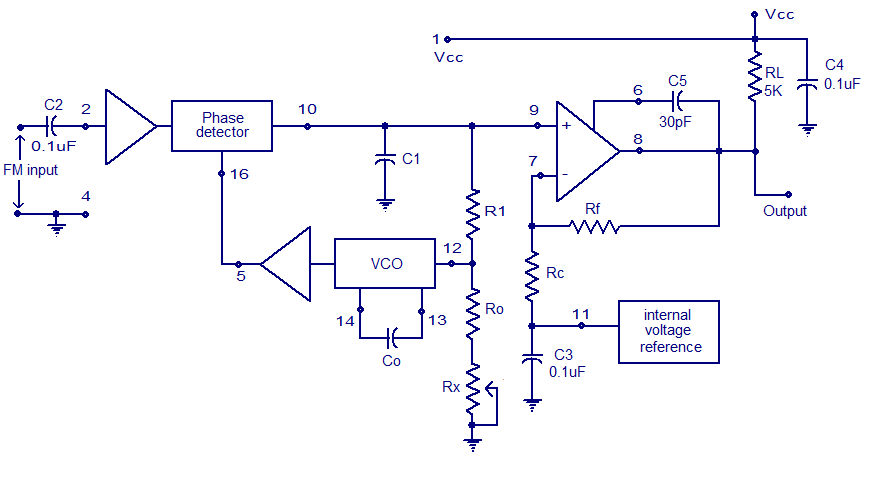
FM receivers with PLL
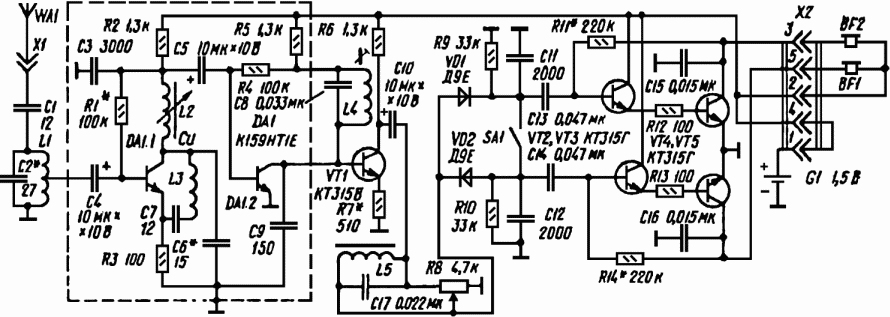
This article discusses simple FM direct conversion radio receivers utilizing a phase-locked loop (PLL). These receivers operate by locking the local oscillator frequency to the input signal. All FM receivers are based on a circuit that combines an oscillator and mixer, functioning as a synchronous detector. The input tank circuit, consisting of L1 and C2, is tuned to the frequency of the received signal, while the local oscillator circuit, represented by L2 and C6, is tuned to a frequency that is half of the input frequency. The conversion occurs at the second harmonic of the local oscillator frequency, resulting in an audio frequency output. The transistor VT1 controls the frequency of the local oscillator; its output conductance, which shunts the resonant tank circuit L2C6, is influenced by the collector current, thus depending on the output signal of the receiver. VT1 is a GT311E, a vintage USSR Germanium high-frequency transistor with specific gain characteristics. This transistor is configured in both common-base and common-emitter modes, serving as the local oscillator and frequency converter, respectively. The input signal from the wideband resonant tank circuit L1C2 is fed to the base of VT1, which is tuned to the middle of the VHF FM band (70 MHz). The local oscillator operates at a frequency range of 32.9 to 37 MHz, with its second harmonic falling within the VHF broadcasting band (65.8 to 74 MHz), which is the first FM band in Eastern Europe. The detector's efficiency is contingent on the level of the second harmonic in the collector current of VT1. To enhance this component's amplitude, the capacitance of capacitor C7 in the positive feedback loop is increased by 2.3 times compared to what is required for oscillation at the first harmonic frequency. The transistor VT1 acts as a synchronous detector, providing audio frequency amplification (low IF), with gain approximately equal to the ratio of resistors R2 to R3. The network formed by R2 and C3 blocks RF frequencies from the local oscillator and serves as the load for the synchronous detector. The time constant of this circuit allows for the passage of the entire frequency range of a complex stereo signal. The capacitance of capacitor C3 can be increased to achieve a standard time constant of 50 microseconds when the receiver is intended for monophonic signal reception. The output signal voltage from the receiver is approximately 10 to 30 mV, sufficient for listening through headphones connected in place of resistor R2, and this output voltage remains constant regardless of the received radio signal level. The sensitivity of this receiver matches that of a super-regenerative radio receiver, and it avoids producing "noise" in the absence of a radio station signal. When the local oscillator is tuned to half the frequency of a radio station, it locks in, producing a "click" in the headphones, after which the receiver tracks the frequency within a certain range and performs synchronous detection. Due to the PLL and effective isolation between the input resonant circuit and the local oscillator resonant circuit, which operate at different resonance frequencies, the receiver generates minimal radiation at the antenna, eliminating the need for an RF amplifier. A limitation of this receiver is that the locking range expands when a strong radio signal is received, potentially leading to AM detection, a common issue for all FM direct conversion receivers utilizing PLL.
The circuit design incorporates critical components that facilitate the functionality of the FM receiver, including the resonant tank circuits, the phase-locked loop mechanism, and the transistor configurations. The input tank circuit (L1C2) is designed to resonate at the desired FM frequency, ensuring optimal signal reception. The local oscillator (L2C6) is carefully tuned to provide the necessary frequency offset, specifically half of the input frequency, which is essential for the conversion process.
The choice of the GT311E transistor is significant due to its high-frequency capabilities and the ability to operate effectively in both common-base and common-emitter configurations. This dual configuration allows for efficient frequency conversion and amplification, which is crucial for maintaining signal integrity and enhancing audio output. The feedback mechanism involving capacitor C7 is vital for stabilizing the oscillator and improving the gain of the second harmonic, which directly influences the audio output quality.
Furthermore, the network formed by resistors R2 and R3, along with capacitor C3, plays a pivotal role in filtering and shaping the output signal. By adjusting the capacitance of C3, the receiver can be optimized for different types of audio signals, accommodating both stereo and monophonic inputs. The design's sensitivity ensures that even weak signals can be adequately processed without introducing significant noise, which is a common challenge in radio receiver design.
Overall, this FM direct conversion receiver exemplifies an effective integration of components and techniques to achieve reliable performance in VHF signal reception, demonstrating the practical application of electronic principles in radio technology.This article describes some simple FM direct conversion radio receivers with phase-locked loop (PLL). This receivers uses the method of locking the local oscillator frequency with the input signal [1]. All this FM receivers are based on the circuit shown in fig. 1. This is a combined oscillator and mixer, and it works as a synchronous detector. Th e input tank circuit L1C2 tuned to the frequency of the received signal, and the local oscillator circuit L2C6 tuned to a frequency less than input frequency in two times. The conversion occurs at the second harmonic of the local oscillator frequency, so the resulting frequency will be in audio frequency range.
The transistor VT1 provides the frequency control of the local oscillator, the output conductance (it shunts the resonant tank circuit L2C6) of the transistor depends on the collector current, therefore it depends on the output signal of the receiver. VT1 - GT311E (an old USSR Germanium high-frequency transistor with hfe=15. 80 (at DC: Uke=3 V, Ie=15 mA), hfe=2. 5 (at f=100 mHz, Ukb=5 V, Ie=5 mA), Ft = 250) The transistor VT1 is configured as a common-base circuit to work as the local oscillator, and in the same time the transistor VT1 is configured as a common-emitter circuit to work as a frequency converter.
From the wide band resonant tank circuit L1C2 the input signal is applied to the base of the transistor VT1. The resonant circuit L1C2 tuned to the middle of the VHF FM band (70 MHz). The local oscillator tuned to the frequency range of 32. 9. 37 MHz, so the frequency of its second harmonic lies in the frequency range of the VHF broadcasting band (65.
8. 74 MHz - this is the first FM band in Eastern Europe). The efficiency of the detector depends on the level of the second harmonic of the local oscillator in the collector current of the transistor VT1. To increase the amplitude of this component, the capacitance of the capacitor C7 in the positive feedback loop is used in 2.
3 times greater than required for the oscillating at the frequency of the first harmonic. The transistor VT1 is configured as a common-base circuit to work as a synchronous detector. This transistor provides a sound amplification of the audio frequency (this is the low IF), the gain is approximately equal to the ratio of resistors R2/R3. The network R2C3 blocks the RF frequency across the local oscillator, and this network is the load of the synchronous detector.
The time constant of this circuit makes it possible to pass the entire frequency range of the complex stereo signal. The capacitance of the capacitor C3 can be increased to get a standard value of the time constant 50 s in case if the receiver will receive only monophonic signal.
The signal voltage at the output of the receiver is approximately 10. 30 mV (this is enough to listen to the radio with headphones connected to the circuit instead of the resistor R2) and this signal voltage is independent of the level of received radio signal. The sensitivity of this receiver is not worse than a sensitivity of a super-regenerative radio receiver, and this receiver don`t have a "noise" sound when there is no signal of a radio station.
At the moment of tuning of the local oscillator to the half of the frequency of a radio station, the frequency locks and we hear a "click" in headphones, and now the receiver tracks the frequency (in some range) and carrying out synchronous detection of a signal. Because of the PLL and a good isolation between the input resonant circuit and the local oscillator resonant circuit (they has different resonance frequency) the receiver produces very low radiation in the antenna, so the receiver don`t need an RF amplifier.
The shortcoming of the receiver is that the locking range getting wider when a powerful radio signal received, and in this case AM detection may happen, but this is the common problem of all FM direct conversion receivers with PLL. A silicon tr 🔗 External reference
The circuit design incorporates critical components that facilitate the functionality of the FM receiver, including the resonant tank circuits, the phase-locked loop mechanism, and the transistor configurations. The input tank circuit (L1C2) is designed to resonate at the desired FM frequency, ensuring optimal signal reception. The local oscillator (L2C6) is carefully tuned to provide the necessary frequency offset, specifically half of the input frequency, which is essential for the conversion process.
The choice of the GT311E transistor is significant due to its high-frequency capabilities and the ability to operate effectively in both common-base and common-emitter configurations. This dual configuration allows for efficient frequency conversion and amplification, which is crucial for maintaining signal integrity and enhancing audio output. The feedback mechanism involving capacitor C7 is vital for stabilizing the oscillator and improving the gain of the second harmonic, which directly influences the audio output quality.
Furthermore, the network formed by resistors R2 and R3, along with capacitor C3, plays a pivotal role in filtering and shaping the output signal. By adjusting the capacitance of C3, the receiver can be optimized for different types of audio signals, accommodating both stereo and monophonic inputs. The design's sensitivity ensures that even weak signals can be adequately processed without introducing significant noise, which is a common challenge in radio receiver design.
Overall, this FM direct conversion receiver exemplifies an effective integration of components and techniques to achieve reliable performance in VHF signal reception, demonstrating the practical application of electronic principles in radio technology.This article describes some simple FM direct conversion radio receivers with phase-locked loop (PLL). This receivers uses the method of locking the local oscillator frequency with the input signal [1]. All this FM receivers are based on the circuit shown in fig. 1. This is a combined oscillator and mixer, and it works as a synchronous detector. Th e input tank circuit L1C2 tuned to the frequency of the received signal, and the local oscillator circuit L2C6 tuned to a frequency less than input frequency in two times. The conversion occurs at the second harmonic of the local oscillator frequency, so the resulting frequency will be in audio frequency range.
The transistor VT1 provides the frequency control of the local oscillator, the output conductance (it shunts the resonant tank circuit L2C6) of the transistor depends on the collector current, therefore it depends on the output signal of the receiver. VT1 - GT311E (an old USSR Germanium high-frequency transistor with hfe=15. 80 (at DC: Uke=3 V, Ie=15 mA), hfe=2. 5 (at f=100 mHz, Ukb=5 V, Ie=5 mA), Ft = 250) The transistor VT1 is configured as a common-base circuit to work as the local oscillator, and in the same time the transistor VT1 is configured as a common-emitter circuit to work as a frequency converter.
From the wide band resonant tank circuit L1C2 the input signal is applied to the base of the transistor VT1. The resonant circuit L1C2 tuned to the middle of the VHF FM band (70 MHz). The local oscillator tuned to the frequency range of 32. 9. 37 MHz, so the frequency of its second harmonic lies in the frequency range of the VHF broadcasting band (65.
8. 74 MHz - this is the first FM band in Eastern Europe). The efficiency of the detector depends on the level of the second harmonic of the local oscillator in the collector current of the transistor VT1. To increase the amplitude of this component, the capacitance of the capacitor C7 in the positive feedback loop is used in 2.
3 times greater than required for the oscillating at the frequency of the first harmonic. The transistor VT1 is configured as a common-base circuit to work as a synchronous detector. This transistor provides a sound amplification of the audio frequency (this is the low IF), the gain is approximately equal to the ratio of resistors R2/R3. The network R2C3 blocks the RF frequency across the local oscillator, and this network is the load of the synchronous detector.
The time constant of this circuit makes it possible to pass the entire frequency range of the complex stereo signal. The capacitance of the capacitor C3 can be increased to get a standard value of the time constant 50 s in case if the receiver will receive only monophonic signal.
The signal voltage at the output of the receiver is approximately 10. 30 mV (this is enough to listen to the radio with headphones connected to the circuit instead of the resistor R2) and this signal voltage is independent of the level of received radio signal. The sensitivity of this receiver is not worse than a sensitivity of a super-regenerative radio receiver, and this receiver don`t have a "noise" sound when there is no signal of a radio station.
At the moment of tuning of the local oscillator to the half of the frequency of a radio station, the frequency locks and we hear a "click" in headphones, and now the receiver tracks the frequency (in some range) and carrying out synchronous detection of a signal. Because of the PLL and a good isolation between the input resonant circuit and the local oscillator resonant circuit (they has different resonance frequency) the receiver produces very low radiation in the antenna, so the receiver don`t need an RF amplifier.
The shortcoming of the receiver is that the locking range getting wider when a powerful radio signal received, and in this case AM detection may happen, but this is the common problem of all FM direct conversion receivers with PLL. A silicon tr 🔗 External reference
